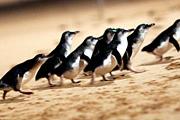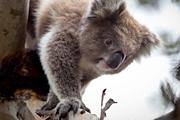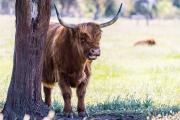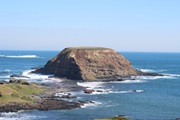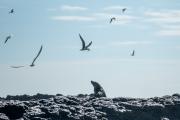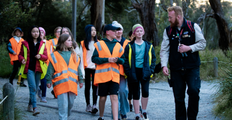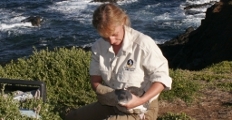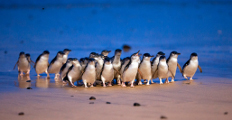Short-tailed shearwaters return to improved habitat
Short-tailed shearwaters have begun arriving at Phillip Island to find newly improved nesting habitat for their breeding season this year.
About 1.4 million of the seabirds return to Phillip Island in late September each year from the waters around Alaska. The timing of their return is usually quite predictable. While they concerningly arrived late for the 2019/20 breeding season, the birds are back to their usual schedule.
Their arrival this year comes as Phillip Island Nature Parks has completed significant habitat revegetation works at Cape Woolamai, which is home to around 540,000 burrows.
Nature Parks Senior Ranger Mark Merryfull said the focus was on removing and preventing weeds that threaten the birds’ nesting environment – including treating 17 hectares of weeds and planting more than 6300 native plants.
“Weeds are a real threat to Short-tailed shearwaters and other ground-nesting birds – they grow over the burrows and prevent the birds from coming back and refurbishing the burrows the birds use to breed in,” he said.
“We’ve improved Short-tailed shearwater habitat by treating more than 17 hectares of smothering grasses and by planting native species that are local to Cape Woolamai, which contribute to suppress weeds.
“Habitat restoration is one piece of the puzzle for ensuring the long-term survival of Shorttailed shearwaters.”
Another piece of that puzzle is research. Nature Parks Deputy Research Director Dr Duncan Sutherland said geolocators were continuing to track the birds’ return journey between the food rich waters around Alaska and Phillip Island where they come to breed.
Tracking data from 2019/20, when the birds’ return was delayed, showed that rather than migrating south as usual, they turned north and spent a few weeks in the Arctic Circle before starting their migration back toward Phillip Island. Another 25 geolocators were deployed last year and more from previous years could still be recovered, shedding more light on the birds’ flight patterns.
“We’re interested in the year-to-year variation in movement patterns as they will help us understand the influence of changing environmental conditions on the persistence and breeding success of these trans-equatorial migrants,” Dr Sutherland said.
“We are seeing significant changes in the sea temperature and extent of sea ice in the northern Bering and Chukchi Seas, near Alaska, driven by climate change.
“In seasons to come, climate change could see shearwaters pushed further north looking for food in the colder, more productive waters, and further delaying their return to breed, with the possibility of missing the breeding window.”
Phillip Island Nature Parks has ramped up its efforts to protect Short-tailed shearwaters with the help of a grant from wildlife advocacy group, WIRES. This includes the habitat restoration, a strengthened rescue capability, enhanced data collection and community education for the benefit of shearwaters.
“Earlier this year we saw a great response from local businesses and residents who turned off their lights and helped reduce light pollution, a simple measure that dramatically reduces the dangers to young shearwaters as they fledge,” Dr Sutherland said.
“Local residents on Phillip Island are encouraged to continue playing their part in protecting these breeding birds and their habitat by ensuring they remain on walking tracks in areas where the shearwaters breed, so as not to disturb or destroy the burrows.
“Keeping cats contained on the owners’ premises at all times and keeping dogs on leads will also go a long way to minimising the threat to these amazing migratory birds.”





